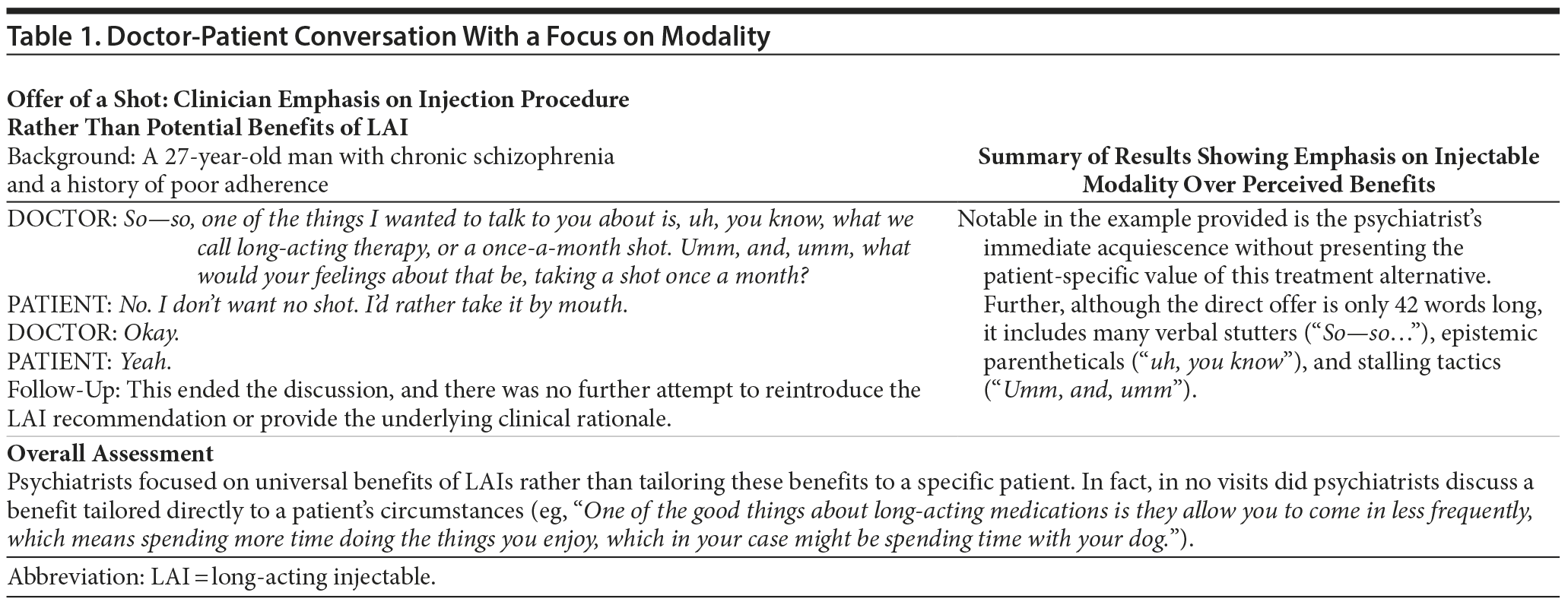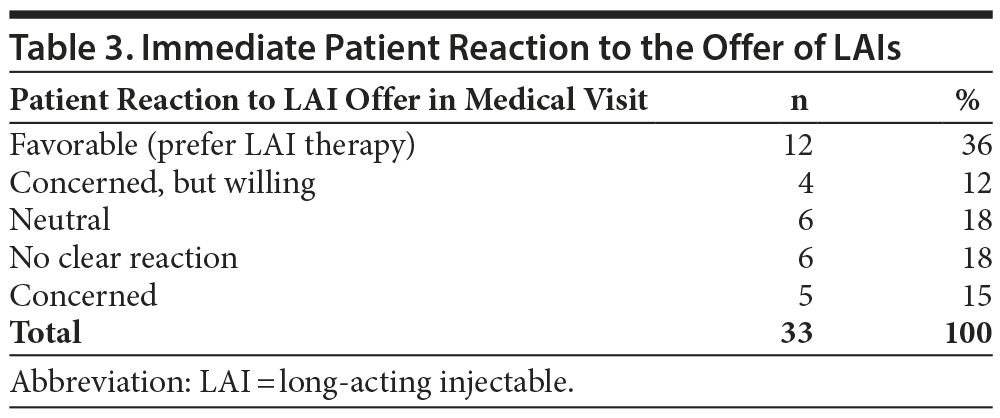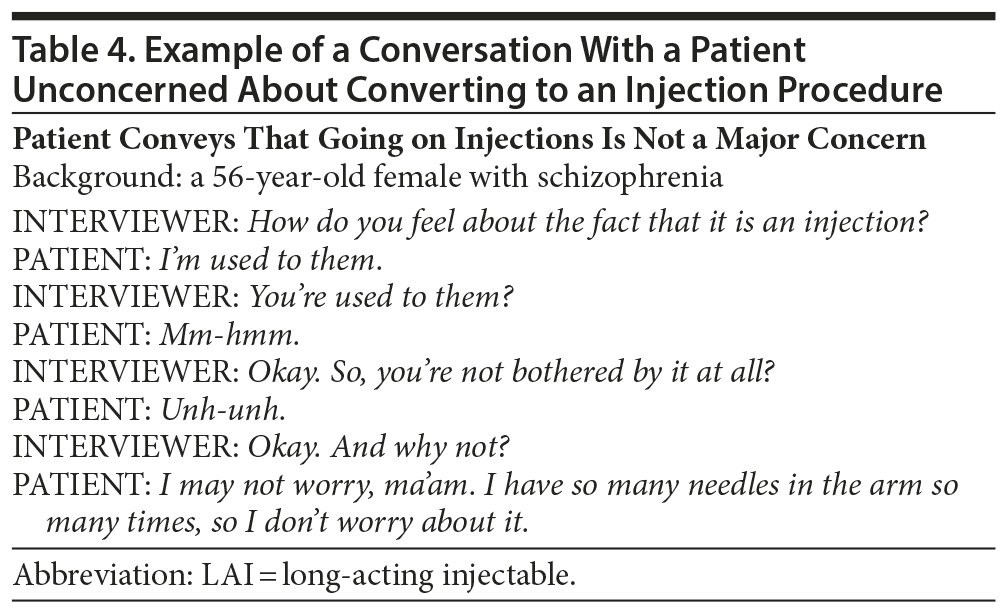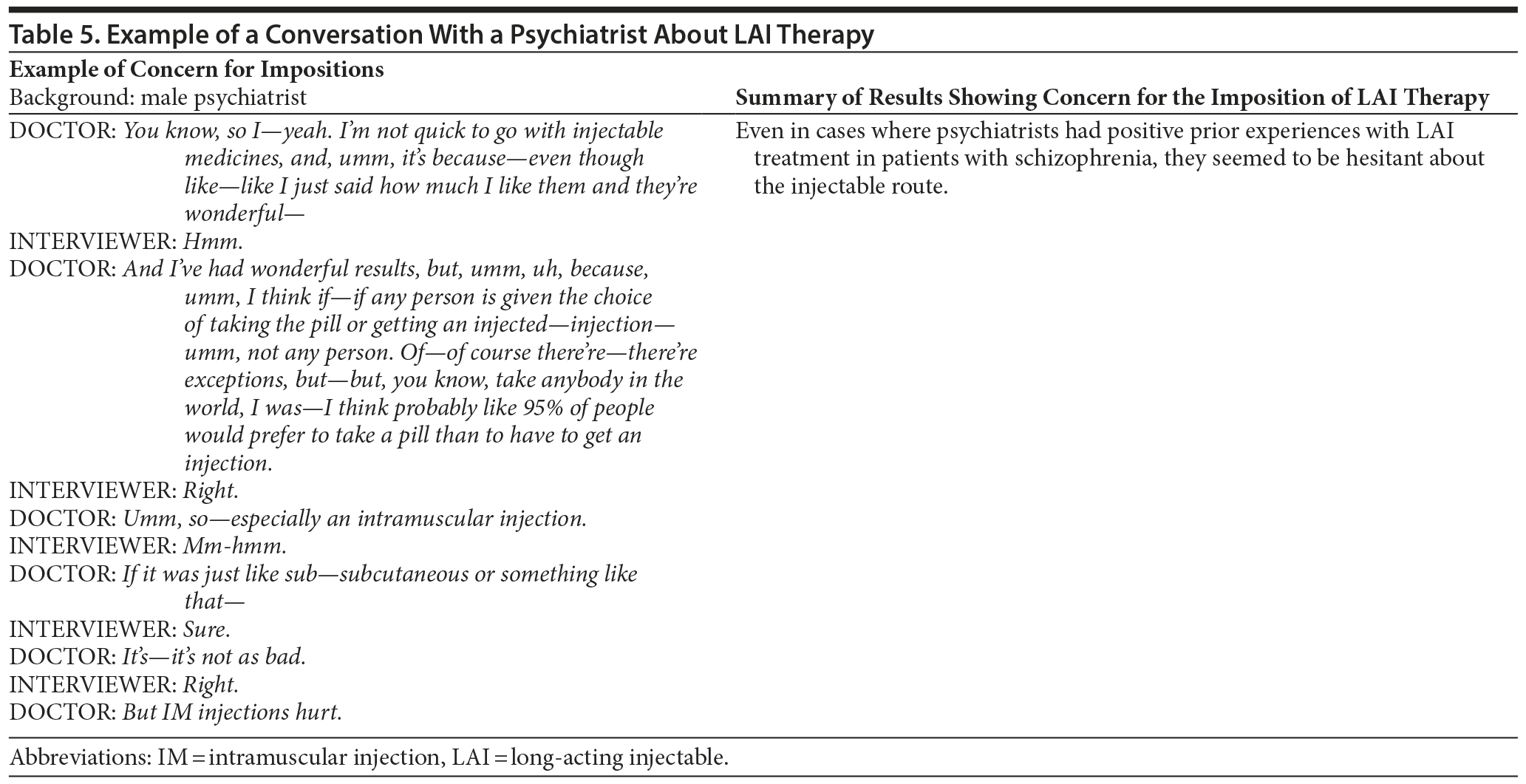Objective: To characterize patterns of communication in the offer of long-acting injectable (LAI) antipsychotic medication made by psychiatrists to patients with schizophrenia by (1) examining the style and content of their interaction and (2) determining how these may have driven the ultimate response to recommendations for LAI therapy.
Method: This was an observational study conducted at 10 community mental health centers in 3 waves from July 2010 to May 2011. The final dataset for discourse analysis was 33 recorded conversations in which a psychiatrist offered an injectable antipsychotic to a patient with schizophrenia. These visits were transcribed and analyzed by a team of linguists and social scientists.
Results: Our primary finding is that, based on analyses of their language during the interview, psychiatrists presented LAI therapy in a negative light. Supporting this, 11 of 33 recommendations (33%) were accepted during the discussion, whereas in the postvisit interview, 27 of 28 patients (96%) who seemed to decline the initial recommendation said they actually would be willing to try LAI treatment.
Conclusions: These data support a preliminary hypothesis that the relatively low use of injectable antipsychotic therapies in the United States relative to other parts of the world is not fully attributable to patient rejection of the injectable modality. Rather, psychiatrists’ ambivalence regarding the value of LAIs may play a significant role in the perceived difficulty with patient acceptance of this recommendation.
This work may not be copied, distributed, displayed, published, reproduced, transmitted, modified, posted, sold, licensed, or used for commercial purposes. By downloading this file, you are agreeing to the publisher’s Terms & Conditions.
ABSTRACT
Objective: To characterize patterns of communication in the offer of long-acting injectable (LAI) antipsychotic medication made by psychiatrists to patients with schizophrenia by (1) examining the style and content of their interaction and (2) determining how these may have driven the ultimate response to recommendations for LAI therapy.
Method: This was an observational study conducted at 10 community mental health centers in 3 waves from July 2010 to May 2011. The final dataset for discourse analysis was 33 recorded conversations in which a psychiatrist offered an injectable antipsychotic to a patient with schizophrenia. These visits were transcribed and analyzed by a team of linguists and social scientists.
Results: Our primary finding is that, based on analyses of their language during the interview, psychiatrists presented LAI therapy in a negative light. Supporting this, 11 of 33 recommendations (33%) were accepted during the discussion, whereas in the postvisit interview, 27 of 28 patients (96%) who seemed to decline the initial recommendation said they actually would be willing to try LAI treatment.
Conclusions: These data support a preliminary hypothesis that the relatively low use of injectable antipsychotic therapies in the United States relative to other parts of the world is not fully attributable to patient rejection of the injectable modality. Rather, psychiatrists’ ambivalence regarding the value of LAIs may play a significant role in the perceived difficulty with patient acceptance of this recommendation.
J Clin Psychiatry 2015;76(6):684-690
© Copyright 2015 Physicians Postgraduate Press, Inc.
Submitted: December 17, 2013; accepted September 11, 2014.
Online ahead of print: April 14, 2015 (doi:10.4088/JCP.13m08946).
Corresponding author: Peter J. Weiden, MD, Department of Psychiatry, University of Illinois at Chicago, 912 South Wood St, Chicago, IL 60612 ([email protected]).
The effectiveness of any treatment is irrelevant if it is not accepted and taken by the patient. While this may seem obvious, there is growing awareness that the doctor-patient relationship, especially doctor-patient communication, is critical for patient treatment acceptance.1-8 Further, the literature on doctor-patient communication clearly suggests that how treatment recommendations are presented can greatly influence the likelihood of their acceptance or refusal.
In this study, we explored the role of doctor-patient communication patterns in the acceptance of long-acting injectable (LAI) treatment in persons with schizophrenia. This therapy represents a potentially effective solution to the pervasive problem of medication nonadherence in schizophrenia, yet LAI therapy is used relatively infrequently.9-16 Recognizing that there may be many reasons for underuse of LAIs, the question we seek to answer is whether this low utilization stems from reluctance on the patient’s part to accept the recommendation or ambivalence on the part of the practitioner to optimally recommend the specific intervention.
The question is particularly relevant, because there is an acknowledged discrepancy between psychiatrists’ stated beliefs in the value of LAIs and their actual practice patterns.17,18 To address this question, we examined conversations between patients and psychiatrists in which LAI therapy was recommended. The form and presentation of the recommendation, the patient’s response and reaction to the recommendation, and whether or not the patient went on to accept treatment with a long-acting antipsychotic were all explored using linguistic analysis of the visit during which the recommendation was made. These doctor-patient interactions were followed with debriefing interviews of the patient to assess the patient’s perspective about the recommendation and the patient’s eventual decision about whether to accept or decline the recommendation.
METHOD
The primary questions evaluated in this study were as follows:
- What, if any, are the limitations of the communication with the patient when LAI antipsychotic medication is recommended as a treatment option?
- Do communication patterns provide information about potential root causes for the relatively low patient acceptance rate of long-acting therapies when offered by psychiatrists to persons with schizophrenia?9-18
This observational, ethnographic study explored these questions by examining the physician’s offer of a LAI antipsychotic as an alternative to oral antipsychotic medication to patients with schizophrenia.
Study Design
The data for this study were collected in accord with standard methodologies for ethnographic research using medical discourse analysis. Discourse analysis studies naturally occurring doctor-patient interactions and generates subsequent analysis of those conversations, focusing on word usage, dialogue dynamics, and fine-grained examination of the conversation. Also, after the actual conversation took place, patients were interviewed by the researchers to review their perspectives on what was discussed and understood. For a more complete explanation of techniques utilized for medical discourse analysis in this study, reference can be made to The Handbook of Discourse Analysis, especially chapter 23, “The Discourse of Medical Encounters.”19

- Many psychiatrists believe that their patients who take oral antipsychotics would, if offered, refuse a recommendation for long-acting injectable (LAI) antipsychotic medications.
- This ethnographic research suggests that the offer of LAI therapy itself is often characterized by hesitation and reluctance and that this may hinder the acceptance rate.
- In interviews, patients confirmed that they might have accepted the offer of LAI therapy if it had been presented differently.
- This study supports a hypothesis that a common reason for nonacceptance of LAI therapy may be that psychiatrists are ambivalent or unenthusiastic about this option even as they recommend it.
Site Selection
All observations took place in community mental health centers (CMHCs) from July 2010 to May 2011. Potential sites were identified through the National Council for Community Behavioral Healthcare (NCCBH). Sites selected for participation predominantly served patient populations diagnosed with severe mental illness and had to have LAI service available on-site to accommodate the possibility of patients on oral antipsychotics changing to the LAI formulations. Sites were excluded if LAIs were primarily used as part of an outpatient commitment program or if LAI use was largely directed toward acute or crisis services. Site recruitment continued until a sample of 10 geographically diverse US facilities were identified.
Subjects
Both psychiatrists and patients were treated as subjects for this research. Accordingly, both parties signed consent forms approved by a third-party independent institutional review board (IRB), which also provided research oversight for the study design and fieldwork. Participants were paid honoraria. The project was designed so as not to influence the psychiatrist’s specific recommendation. For this reason, the specific focus of the study was not identified to either psychiatrists or patients nor was the study’s sponsor revealed to participants.
Psychiatrists included in this study had to be employed at a participating CMHC and be both knowledgeable about and experienced with the use of LAIs as maintenance treatment for patients with schizophrenia. Finally, they had to consent to participate in recorded interviews with participating patients and to discuss those interviews with an ethnographic researcher.
Patients included in this study were first identified by their physician. They must have had a clinical diagnosis of schizophrenia as indicated by their treating psychiatrist, have been viewed by their physician as a candidate for LAI use, and have not previously received treatment with LAIs. They were also required to have an established relationship with the psychiatrist selected for study.
Psychiatrist-Patient Dialogues
Patients came to regularly scheduled clinic visits for medical care without foreknowledge of the ongoing research. Upon the patient’s arrival, the possibility of research was broached by office staff or the psychiatrist. After consent was obtained from both the psychiatrist and patient, a video/audio recorder was placed in the office by the ethnographic researcher. Immediately thereafter, the ethnographer exited the office, and the visit took place as it would normally have occurred. The methodology employed followed best practice linguistics guidelines for generating analyzable data20-22 that support hypotheses regarding patient-provider discourse.
Three individual waves of research occurred, each separated by several months’ time. The interviews conducted at the end of each wave were specific to the observations and fieldwork that occurred within that wave. Therefore, the general interviews that occurred at the end of wave 1 were specific only to the institutional observation that occurred during that wave. Interviews from wave 2 were specific only to the physician-patient dialogues that were the focus of and were captured during the second wave’s fieldwork. Likewise, interviews during wave 3 were specific only to the physician-patient dialogues that were captured during the fieldwork from wave 3. By focusing on different objectives and observing and interviewing psychiatrists in different settings, we minimized the possibility that a psychiatrist would be able to leverage any insights he/she may have acquired from their wave 1 interview to the interaction they had with their patient in subsequent waves.
In wave 1, 10 CMHC sites were visited for ethnographic observation focusing on institutional practices and provider behavior around LAI use. This included in-depth psychiatrist interviews focused broadly on their beliefs and attitudes toward LAIs.
In wave 2, the focus was on the doctor-patient dialogue. In this wave, psychiatrists at 5 of the wave 1 sites were instructed to audio record up to 10 LAI-candidate patients, so that the offers of LAI treatment could be observed. Follow-up phone interviews were scheduled with a subset of patients within 1 week of the recorded psychiatrist-patient visit to assess their beliefs about LAI treatment. Separate phone interviews were conducted with each prescribing psychiatrist at the conclusion of the patient-recording phase.
In wave 3, more detailed information was provided on the specific moment at which psychiatrists introduced LAI therapy to their patients. Two CMHCs, which had not been part of the first 2 waves of research, were contacted to avoid potential biases arising from experience during the first 2 waves. Health care providers identified all patients who were eligible for a change in antipsychotic medication. All patients who met these criteria and agreed to video and audio recordings were included in the study, regardless of the antipsychotic medication or the formulation (oral or injectable) that was introduced. Both audio and video recordings were made of the dialogues between consenting candidate patients and their treating physicians.
Clinician and Patient Sample
The 3 waves of research yielded a large volume of data including ethnographic field notes, recorded interviews with psychiatrists, and the actual taped psychiatrist-patient dialogues. For the current analysis, focus was on the 33 recorded dialogues during which LAI antipsychotic medication was offered or discussed in some form. Wave 1 yielded 10 psychiatrists from 10 sites. Five of those 10 sites then participated in wave 2, with 1 psychiatrist from each location for a total of 5 psychiatrists. In addition, 33 patients participated in wave 2; 7 from the first location and 10, 8, 5, and 3 patients from the second, third, fourth, and fifth sites, respectively. Two sites participated in wave 3, yielding 1 psychiatrist and 7 patients from the first site and 1 psychiatrist and 2 patients from the second site. In addition to these dialogues, postvisit interviews with the patients and psychiatrists were analyzed. These included a mix of live and telephone interviews, conducted between 5 minutes and several days after the recorded doctor-patient visit, and the psychiatrists’ general interview tapes and transcripts. These postvisit interviews and general interviews allowed for a better understanding of what patients and providers remembered of their speech, intentions, and overall understanding of the specific interactions. In addition, the psychiatrists’ attitudes toward use of LAIs as an option for treatment of the individuals were discussed.
Analysis
All visits and postvisit interviews were transcribed from recordings. When available, videotapes provided a means for quality control and provided valuable nonverbal cues (eg, nodding, body language) that were not available in the audio tapes alone. Transcripts were then analyzed systematically by a team of linguists (principally B.D. and M.D., with help from those listed in the acknowledgments) using techniques from interactional sociolinguistics including word-, phrase-, question-, and discourse-level analyses of conversation.23,24 Each transcript was analyzed by at least 3 members of the linguistic team.
Efforts were made to account for all available data, but only data judged to be uniformly consistent by M.D. and B.D. were considered representative. Not all linguistic data are easily quantified; where possible and fruitful this was done, but for those assertions for which no quantitative data were given, claims were made based on the frequency of observed patterns.
RESULTS
During the general interview phase of the wave 1 research, the participating psychiatrists stated that the primary reason that LAI therapy is “underutilized” (their word) is patient rejection—in their words, patient refusal to accept LAI antipsychotic medication as a viable therapy is common. Given this assertion, patient refusals should have been verifiable and visible in the encounters that were recorded.
Three key results of our sociolinguistic analysis were identified as common patterns within the LAI offer dialogue and categorized as: (1) clinician emphasis on injection procedure rather than potential benefits of LAI, (2) clinician perception of LAI rejection not in evidence, and (3) LAI recommendation often presented as an “imposition.”
Result Category 1:
Clinician emphasis on injection procedure rather than potential benefits of LAI
The offer of the LAI antipsychotic medication as a treatment alternative nearly always followed a pattern emphasizing the modality rather than the value that the new treatment approach might provide. Specifically, patients were usually told that they were to receive “a shot” or “an injection” with minimal focus on its benefits, such as receiving a medication that did not have to be taken every day. Specifically, 30 of 33 discussions of LAI treatment (91%) in wave 2 focused on the modality, whereas 3 of 33 (9%) emphasized the benefits of the injection. An example of focusing on the modality is provided in Table 1.
“Hedging” was also demonstrated during presentation of LAIs. When employing this pattern, the psychiatrist asked the patient not to consider switching to LAI antipsychotic medication immediately, but to consider switching at some point in the future, as shown in Table 2.
Result Category 2:
Clinician perception of LAI rejection not in evidence
Analysis by independent raters of the patients’ immediate responses to the offers of LAIs is summarized in Table 3. Of the 33 offers analyzed, full rejections of those offers as a therapeutic option were notably absent. Similar to Potkin et al,25 we found that rejection of the offer was common, but the rejection was of the modality (“shots” or “injections”) rather than the therapy itself. Even with the initial negative reaction to modality, 22 of 33 patients (67%) expressed either neutral or positive reactions to the overall offer of an LAI. Of the 22 patients indicating a potential willingness to try LAI, the physician indicated that LAI therapy would be initiated in 11 of these patients (50%).
In postvisit interviews, patients were probed regarding their feelings about certain medications. In particular, general questions were asked about the patients’ reactions to the visit during which the offer of LAIs was made. Of the 28 (of 33) wave 2 patients who agreed to participate in a follow-up telephone interview, 1 expressed complete refusal to try an LAI, whereas the remaining 27 expressed willingness to try this form of treatment. Concerns about needles were identified in 9 of 28 patients (32%). Of these 9 responses, most common was an expression that needles, while not liked, were acceptable. Ten of 28 patients (36%) expressed no concerns about needles. An example of such a conversation from a postvisit phone interview is provided in Table 4.
Result Category 3:
LAI recommendation often presented as an “imposition”
In follow-up interviews, a consistent explanation for the presentation style of the offer was that the psychiatrists did not want to “force” their patients to take LAIs. This was seen both in direct answers to questions and in the language used to frame the initiation of the LAI therapy (eg, that by offering treatment with LAI formulations, the psychiatrist was “imposing” his will upon his patient). Equivalent concerns that the psychiatrist was imposing a burden on his patients when offering oral antipsychotic therapy were absent.
Table 5 provides an example of a psychiatrist with a prior good experience with LAI treatment in a patient with schizophrenia who was asked if he would expand on that experience and use LAIs in other patients who were early in the course of their disease.
DISCUSSION
This report identified several styles for presenting and responding to the offer of LAIs that raise questions about how LAIs are introduced to psychiatric patients. Among the interactional sociolinguistic outcomes that were commonly identified during presentation of the offer of LAIs were prioritizing of risks over benefits, failure to provide a strong patient-specific rationale for the offer, tentativeness and “hedging” of the offer, and the psychiatrist’s identification of the offer as an imposition. Somewhat surprisingly, despite prior assertions of psychiatrists’ experience, most patients did not fully reject the LAI offer and were willing to have follow-up conversations about this treatment option.
Decisions regarding pharmacologic treatment are integral to the recovery process for patients with mental illness. Ideally, the patient and psychiatrist work together in a collaborative format with the goal of reestablishing or maintaining improved functionality.13 Medication changes are typically made only in response to a failure of the immediately prior therapeutic approach.26 This psychiatrist-patient dialogue would be expected to cover issues that might affect therapeutic outcome, including anything that interferes with the current therapy: cost, side effects, lack of efficacy, and lack of adherence. In psychiatry, where the psychiatrist-patient dialogue forms a critical component of the “therapeutic alliance,” selection and discussion of therapy, including how well or poorly the offer is made and discussed, are of particularly critical significance.27,28
In the examples evaluated here, offers of LAI treatment followed a pattern that differs considerably from the physician approach to recommendations for other, far more painful and intrusive, medical approaches, like lumbar punctures.29,30 These differences are exemplified in multiple ways.
While it is true that LAI treatment is an injectable form of therapy, it is also true that the modality of delivery is not the sole reason why LAI therapy represents a medically valuable option. If the proponent of that option is convinced of its value, it seems unusual that the presentation would be introduced as a painful and intrusive “shot” before providing its rationale and value. Most of LAI introductions in this sample (91%) focused on the modality of its delivery. This robust finding suggests a general pattern for these dialogues between psychiatrists and patients. Further, in the examples observed, the rapid retreat from the offer even before the offer is clearly rejected is noteworthy. This retreat without the lack of a clear patient rejection is not an expected pattern. In other situations, psychiatrists are more likely to mount a counter-argument to an initial patient rejection if the offer represents one to which they are committed.31 Indeed, it seems unusual for any clinician who has identified the best therapeutic option for a specific patient to withdraw the offer for that treatment with such minimal, and at times nonexistent, patient rejection or concern.
The manner of the offer of LAIs suggests ambivalence toward this option. In the offer for other therapies observed in this study (for example, a mood stabilizer or an antidepressant), patient resistance was almost universally met with a second attempt by the physician to convince the patient of the importance of therapy. In contrast, the offer of LAIs in this study was generally characterized by a rapid and easy retreat in the face of patient rejection or even, in most cases, expressions of concern. In some cases, this was accompanied with a “priming for negation” or an immediate apology once the offer was made (“Yes, lots of people don’ t like injections.”).
A potential cause of psychiatrist ambivalence was provided in some of the postdialogue interviews in which some of the psychiatrists expressed concern that making an LAI recommendation might threaten the delicate therapeutic alliance with the patient. Although speculative in nature, it is also possible that psychiatrists’ bias to LAIs may be, at least in part, determined by their initial experience with LAI therapies. The residency period, during which psychiatrists’ first experience with LAI therapies could have originated as a court-ordered inpatient treatment, may have affected their attitude toward LAIs. Such an experience could have contributed to enduring negative attitudes toward injectable treatments generally. Other possible reasons for the observed reluctance to make an offer of LAIs include disruption of patient-flow dynamics of the treatment setting, requirements for additional personnel, and other challenges arising from the management of injections in a busy practice. None of these reasons are mutually exclusive.
The clinician’s comment (Table 2) that “no one’s gonna force that [an injection] on you” raises questions about the adequacy of clinical training regarding the use of LAIs. In other medical settings, if injections are deemed the optimal therapeutic modality (eg, use of injections for treating diabetes, rheumatoid arthritis, or tetanus), a patient’s fear of needles would not likely be the end of a conversation. Indeed, it might be the beginning. Thus, if use of injectable medications represents a valuable tool for treating severe mental disorders, this ethnographic work suggests that training clinicians on how to introduce and address likely concerns regarding injectable treatments would be a valuable addition to their psychiatric education.
Our data suggest that the feared threat to the therapeutic alliance may be overblown. The patients who were offered or who were eligible for LAIs were not usually in favor of needles. On balance, however, they were willing to undergo injection for a therapy that might make life more convenient, or might aid their adherence. Delays to initiating LAI treatment were usually not patient-driven in the cases we observed. In fact, it was the prescriber who usually chose to procrastinate the initiation of therapy, even in the face of a positive patient response.
Limitations
This report describes observational social science research for which the analytic model employed was retrospective and exploratory. It is difficult to determine the meaningfulness of some of the differences that were identified through these linguistic analyses. For example, terms like “injectable” and “injection” were not used in equivalent patterns by participating psychiatrists. The clinical relevance of such differential linguistic usage patterns is uncertain. Because of this, findings that are likely only of linguistic interest are not discussed in this report.
Another possible limitation of this study stems from potential sources of bias. It is conceivable that the study sponsor could have been “guessed” by the clinicians involved in the interviews. However, if “unmasking” took place, one might expect that clinicians would have been more enthusiastic during their conversations with patients, knowing that the discussions were recorded. The study sponsor initially provided key areas of interest for analytic review, but at no time during the study did they have direct access to the full data. The linguistic team analyzed the data with the intent of providing an explanation, whether favorable or unfavorable, for the low patient acceptance rate of LAIs.
This work suggests that the psychiatrist-patient dialogue around the initiation of LAIs is characterized by ambivalence. The data from this sample suggest that the barrier to acceptance of the offer is not based on patients’ refusals or the attitudes patients have toward injections. Rather, the barrier appears to arise from a lack of conviction in the value of the offer and a projected reluctance on the part of the psychiatrists to use injection formulations as a therapeutic option. However, the sample studied was small and was not collected as a randomized sample of either CMHCs in the United States or of psychiatrists from those settings. Therefore, the degree to which the results would generalize to a broader group of psychiatrists from more diverse settings is unclear, and additional hypothesis-testing work should be done.
If results of this preliminary work are borne out, a path forward may include training psychiatrists and other clinicians about the appropriate clinical value of LAIs and in ways of offering this option using a more relationship-building approach.
Author affiliations: Department of Psychiatry, University of Illinois at Chicago (Dr Weiden); Department of Psychiatry, Division of Schizophrenia and Related Disorders, University of Texas Health Science Center, San Antonio (Dr Roma); Community Treatment Team, Mercy Behavioral Health Pittsburgh, Pennsylvania (Dr Velligan); Therapeutic Area Lead Psychiatry, Janssen Scientific Affairs, Titusville, New Jersey (Dr Alphs); and Ogilvy CommonHealth Behavioral Insights, Parsippany, New Jersey (Dr Davidson and Mr DiChiara).
Potential conflicts of interest: Dr Weiden has worked as a consultant for Delpor, Johnson & Johnson (Janssen), Lundbeck, Otsuka USA, Merck, Novartis, Sunovion, and Genentech/Roche; has presented at speaker bureaus on behalf of Johnson & Johnson (Janssen), Merck, Novartis, and Sunovion; has also received grant support from Genentech/Roche, Johnson & Johnson (Janssen), NIMH, Novartis, Sunovion, and Neurocrine; and is a stockholder of Delpor. Dr Roma has presented at speaker/advisory boards on behalf of Janssen, Sunovion, and Otsuka. Dr Velligan has been a consultant for Janssen, Otsuka-Lundbeck, Amgen, and Genentech-La Roche; has received grant support from Amgen, Genentech, and La Roche, and honoraria from Abbvie; and has presented at speaker/advisory boards on behalf of Janssen, Otsuka, Lundbeck, Amgen, Genentech-La Roche, and En Vivo. Dr Alphs is an employee of Janssen Scientific Affairs and a stockholder of Johnson & Johnson. Dr Davidson and Mr DiChiara acted as consultants to Janssen Pharmaceuticals, Inc, who provided funding for the research and writing of the report.
Funding/support: Provided by Janssen Pharmaceuticals, Inc, in the form of financial support for the research, analysis, and writing of the report, as well as presentation of much of the data at the 2011 US Psychiatric Congress. Dr Weiden was provided support for his assistance in research design and the writing of the report.
Disclaimer: The views expressed in this article are those of the authors and not an official position of the institution or funder.
Previous presentation: Two posters presented at the 2011 US Psychiatric Congress; November 7-10, 2011; Las Vegas, Nevada.
Acknowledgments: Thanks for significant contributions to the following: Katy Hewett, MA; Jessica Hill, BS; and Ashli Sherman, BS, all from Ogilvy CommonHealth Behavioral Insights, Parsippany, NJ; and all participating clinicians and patients (who will remain anonymous but without whose contribution this study would not have taken place). Mss Hewett, Hill, and Sherman each work for Ogilvy CommonHealth Behavioral Insights, which received funding from Janssen Pharmaceuticals, Inc, to complete the research, analysis, and writing of the report.
REFERENCES
1. Frongillo M, Feibelmann S, Belkora J, et al. Is there shared decision making when the provider makes a recommendation? Patient Educ Couns. 2013;90(1):69-73. PubMed doi:10.1016/j.pec.2012.08.016
2. Gwyn R, Elwyn G. When is a shared decision not (quite) a shared decision? negotiating preferences in a general practice encounter. Soc Sci Med. 1999;49(4):437-447. PubMed doi:10.1016/S0277-9536(99)00067-2
3. Kunt T, Snoek FJ. Barriers to insulin initiation and intensification and how to overcome them. Int J Clin Pract suppl. 2009;63(164):6-10. PubMed doi:10.1111/j.1742-1241.2009.02176.x
4. Hamann J, Cohen R, Leucht S, et al. Do patients with schizophrenia wish to be involved in decisions about their medical treatment? Am J Psychiatry. 2005;162(12):2382-2384. PubMed doi:10.1176/appi.ajp.162.12.2382
5. Hamann J, Cohen R, Leucht S, et al. Shared decision making and long-term outcome in schizophrenia treatment. J Clin Psychiatry. 2007;68(7):992-997. PubMed doi:10.4088/JCP.v68n0703
6. Hamann J, Mendel RT, Fink B, et al. Patients’ and psychiatrists’ perceptions of clinical decisions during schizophrenia treatment. J Nerv Ment Dis. 2008;196(4):329-332. PubMed doi:10.1097/NMD.0b013e31816a62a0
7. McNeil BJ, Pauker SG, Sox HC Jr, et al. On the elicitation of preferences for alternative therapies. N Engl J Med. 1982;306(21):1259-1262. PubMed doi:10.1056/NEJM198205273062103
8. Ledford CJW, Villagran MM, Kreps GL, et al. “Practicing medicine”: patient perceptions of physician communication and the process of prescription. Patient Educ Couns. 2010;80(3):384-392. PubMed doi:10.1016/j.pec.2010.06.033
9. Velligan DI, Weiden PJ, Sajatovic M, et al. Strategies for addressing adherence problems in patients with serious and persistent mental illness: recommendations from the expert consensus guidelines. J Psychiatr Pract. 2010;16(5):306-324. PubMed doi:10.1097/01.pra.0000388626.98662.a0
10. Velligan DI, Lam F, Ereshefsky L, et al. Psychopharmacology: perspectives on medication adherence and atypical antipsychotic medications. Psychiatr Serv. 2003;54(5):665-667. PubMed doi:10.1176/appi.ps.54.5.665
11. Weiden PJ, Zygmunt A. Medication noncompliance in schizophrenia, part 1: assessment. J Pract Psychiatry Behav Health. 1997;3:106-110.
12. Kane JM, Aguglia E, Altamura AC, et al. Guidelines for depot antipsychotic treatment in schizophrenia. European Neuropsychopharmacology Consensus Conference in Siena, Italy. Eur Neuropsychopharmacol. 1998;8(1):55-66. PubMed doi:10.1016/S0924-977X(97)00045-X
13. Lehman AF, Lieberman JA, Dixon LB, et al; American Psychiatric Association; Steering Committee on Practice Guidelines. Practice guideline for the treatment of patients with schizophrenia, second edition. Am J Psychiatry. 2004;161(suppl):1-56. PubMed
14. Velligan DI, Medellin E, Draper M, et al. Barriers to, and strategies for, starting a long acting injection clinic in a community mental health center. Community Ment Health J. 2011;47(6):654-659. PubMed doi:10.1007/s10597-011-9389-6
15. Patel MX, de Zoysa N, Bernadt M, et al. A cross-sectional study of patients’ perspectives on adherence to antipsychotic medication: depot versus oral. J Clin Psychiatry. 2008;69(10):1548-1556. PubMed doi:10.4088/JCP.v69n1004
16. Patel MX, DE Zoysa N, Baker D, et al. Antipsychotic depot medication and attitudes of community psychiatric nurses. J Psychiatr Ment Health Nurs. 2005;12(2):237-244. PubMed doi:10.1111/j.1365-2850.2004.00826.x
17. Patel MX, Haddad PM, Chaudhry IB, et al. Psychiatrists’ use, knowledge and attitudes to first- and second-generation antipsychotic long-acting injections: comparisons over 5 years. J Psychopharmacol. 2010;24(10):1473-1482. PubMed doi:10.1177/0269881109104882
18. Heres S, Hamann J, Kissling W, et al. Attitudes of psychiatrists toward antipsychotic depot medication. J Clin Psychiatry. 2006;67(12):1948-1953. PubMed doi:10.4088/JCP.v67n1216
19. Ainsworth-Vaughn N. Chapter 23, The discourse of medical encounters. In: Schiffrin D, Tannen D, Hamilton HE, eds. The Handbook of Discourse Analysis.Oxford, UK: Blackwell Publishing; 2001:453-469. doi:10.1111/b.9780631205968.2003.00024.x
20. Aranguri C, Davidson B, Ramirez R. Patterns of communication through interpreters: a detailed sociolinguistic analysis. J Gen Intern Med. 2006;21(6):623-629. PubMed doi:10.1111/j.1525-1497.2006.00451.x
21. Davidson B, Blum D, Cella D, et al. Communicating about chemotherapy-induced anemia. J Support Oncol. 2007;5(1):36-40, 46. PubMed
22. Hamilton HE, Nelson M, Martin P, et al. Provider-patient in-office discussions of response to hepatitis C antiviral therapy and impact on patient comprehension. Clin Gastroenterol Hepatol. 2006;4(4):507-513. PubMed doi:10.1016/j.cgh.2005.10.008
23. Gumperz JJ. On interactional sociolinguistic method. In: Sarangi S, Roberts C, eds. Talk, Work and Institutional Order. Discourse in Medical, Mediation and Management Settings. Berlin, Germany: Mouton de Gruyter; 1999:453-472. doi:10.1515/9783110208375.4.453
24. Hamilton HE. Symptoms and signs in particular: the influence of the medical concern on the shape of physician-patient talk. Commun Med. 2004;1(1):59-70. PubMed doi:10.1515/come.2004.006
25. Potkin S, Bera R, Zubek D, et al. Patient and prescriber perspectives on long-acting injectable (LAI) antipsychotics and analysis of in-office discussion regarding LAI treatment for schizophrenia. BMC Psychiatry. 2013;13(1):261. PubMed doi:10.1186/1471-244X-13-261
26. Thibaut F. Acute treatment of schizophrenia: introduction to the Word Federation of Societies of Biological Psychiatry guidelines. Psychiatr Danub. 2014;26(1):2-11. PubMed
27. Frank AF, Gunderson JG. The role of the therapeutic alliance in the treatment of schizophrenia: relationship to course and outcome. Arch Gen Psychiatry. 1990;47(3):228-236. PubMed doi:10.1001/archpsyc.1990.01810150028006
28. Weiss KA, Smith TE, Hull JW, et al. Predictors of risk of nonadherence in outpatients with schizophrenia and other psychotic disorders. Schizophr Bull. 2002;28(2):341-349. PubMed doi:10.1093/oxfordjournals.schbul.a006943
29. Koenig CJ. Patient resistance as agency in treatment decisions. Soc Sci Med. 2011;72(7):1105-1114. PubMed doi:10.1016/j.socscimed.2011.02.010
30. Gurmankin AD, Baron J, Hershey JC, et al. The role of physicians’ recommendations in medical treatment decisions. Med Decis Making. 2002;22(3):262-271. PubMed
31. Ainsworth-Vaughn N. Claiming Power in Doctor-Patient Talk (Oxford Studies in Sociolinguistics). New York, NY: Oxford University Press; 1998:1.
This PDF is free for all visitors!









